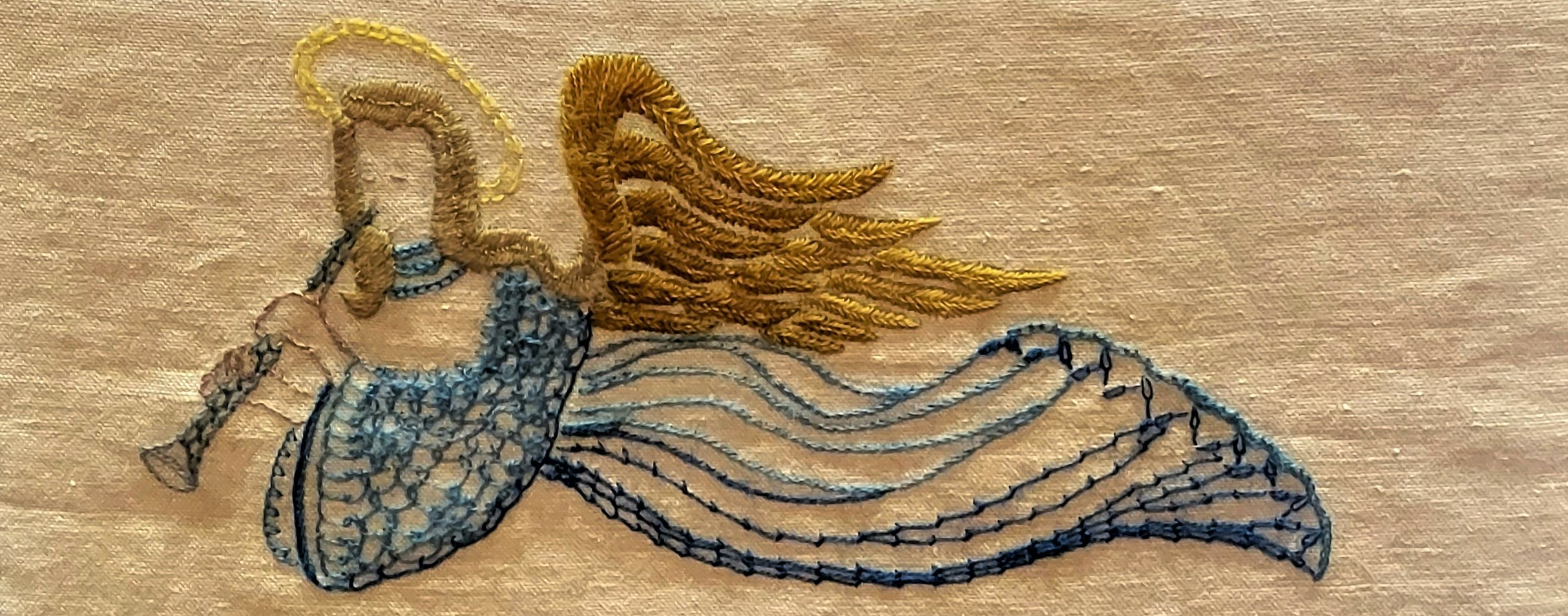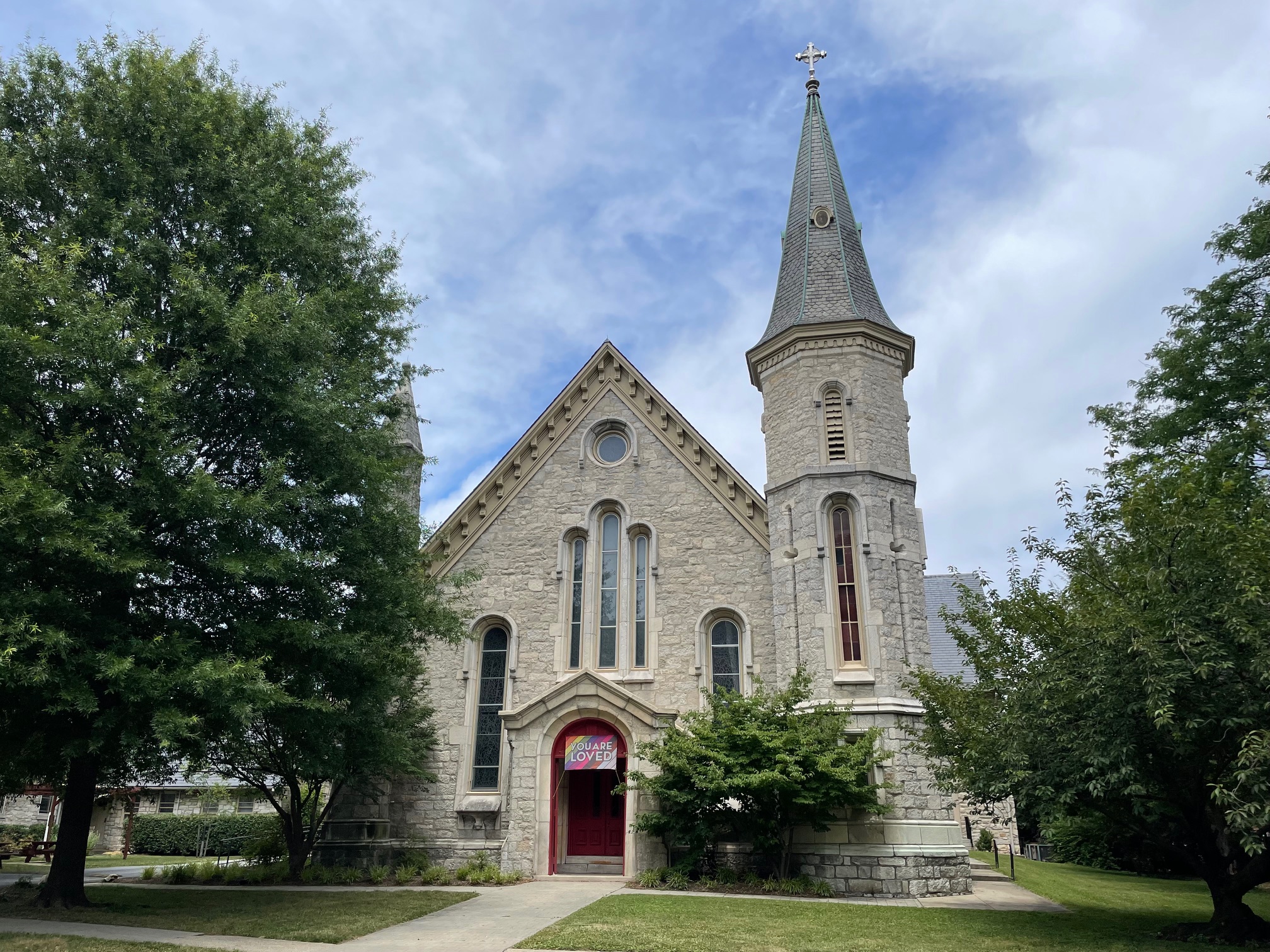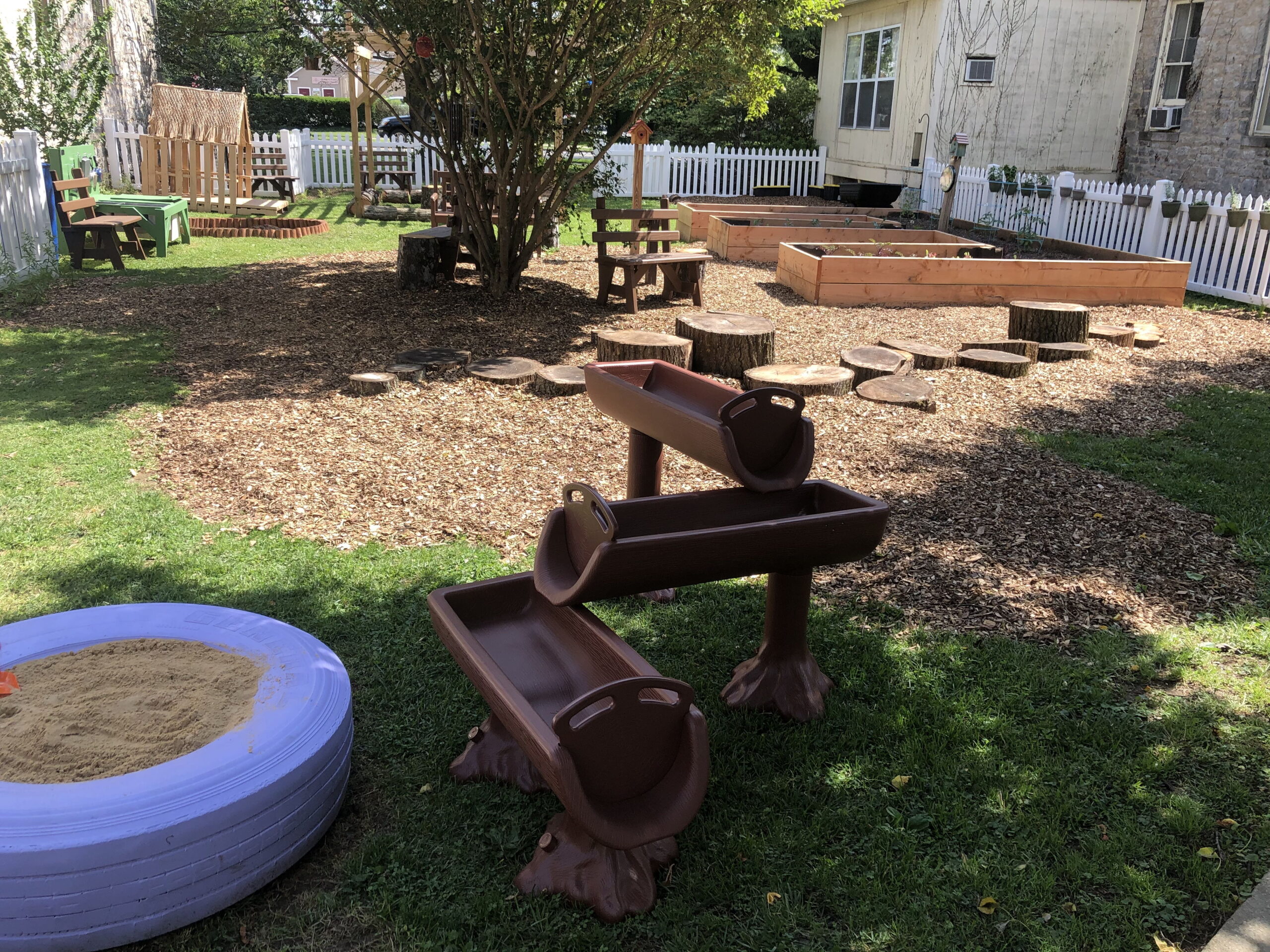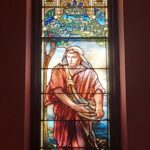Our Beautiful Church Campus
Trinity Stained-Glass Windows
Trinity Church is blessed with some outstanding stained-glass windows. Four of them are from the renowned Tiffany studio in New York. The many blue windows owe their existence to J. Rieman McIntosh. The vestryman in 1956 initiated a project to replace the existing nondescript windows. With help from other church members, he chose a theme of Jesus’ life from the Annunciation to the Ascension. He contracted and paid for their creation and invited anyone who wanted to dedicate a window to do so by making a gift to the Trinity Endowment Fund.
Here are our windows, starting with the Chancel window and proceeding clockwise around the church:
Chancel
The Last Supper, the “Roberts Window,” dedicated to William Christian Roberts (1901-1971), who served as Trinity’s fourth rector, 1944-1969
Lee Chapel
- Tiffany window, The Sower of the Seeds parable, dedicated to banker Thomas Hambleton (1829-1906)
- Tiffany window, angel and cherubim, dedicated to philanthropist Charles Markell (1826-1908), a Trinity vestryman, 1872-1878, and his wife Charlotte Amelia Trail Markell (1827-1906)
- Jesus, dedicated to Harry G. Campbell, Jr. (1916-1993), whose family quarries furnished much of the stone for Trinity’s buildings
Nave, east side, in order from Lee Chapel to the front door
 Tiffany window, the resurrection of Jairus’ daughter by Jesus, dedicated to Virginia McIntosh (1866-1896), daughter of vestryman David G. McIntosh
Tiffany window, the resurrection of Jairus’ daughter by Jesus, dedicated to Virginia McIntosh (1866-1896), daughter of vestryman David G. McIntosh- Upper: the meeting of Mary and Elizabeth after the Annunciation; lower: Mary and Joseph arriving at the inn in Bethlehem, dedicated to David Stewart Ridgely (1884-1978), who served as senior warden, 1959-1971
- Upper: the seer Simeon; lower: the Holy Family journeying on the flight to Egypt, dedicated to Hercules Courtenay Jenifer (1884-1965), a longtime state prosecutor and a vestryman, 1938-1965, and his wife Ilma Massenburg Jenifer (1890-1975)
- From left to right: the shepherds being dazzled by the heavenly host, the scene in the stable, and the Magi in all their finery, dedicated to David Gregg McIntosh (1877-1940), a lawyer and politician who served as a vestryman, 1902-1940, and his wife Charlotte Lowe Reiman McIntosh (1880-1967), a civic activist and leader
- Upper: Jesus confounding the sages in the Temple; lower: working in his father’s carpenter shop, dedicated to Grace May Taber Campbell (1889-1968), a longtime arts and library supporter
- Upper: Jesus calling Andrew and Peter; lower: the baptism of Jesus by John, dedicated to H. Guy Campbell (1861-1967), a quarrying contractor, banker, and civic leader
Balcony
- Upper: the wedding at Cana; lower: St. Michael as the archangel vanquishing Satan, who has taken the form of a dragon, dedicated to Elizabeth Collings Dunning (1870-1966)
- The Transfiguration, dedicated to David Gregg McIntosh (1836-1916), a prominent lawyer who served on the vestry, 1877-1880, and his wife Virginia Johnson Pegram McIntosh (1843-1920)
- Upper: the paralytic in Capernaum being lowered into Jesus’ presence through the roof; lower: the Annunciation, dedicated to Margaretta Sophia Ridgely (1869-1949), who left Hampton to be a missionary in Liberia
Nave, west side, in order from the front door to the chapel
- Upper: Jesus delivering the Sermon on the Mount; lower: “suffer the little children to come unto me,” dedicated to a child, Holly Ruth Stahl (1956-1963), the daughter of Robert Stahl (1920-2003), a World War II spy and later an engineer and vestryman, 1994-1999, and Ruth Rolin Stahl (1922-)
- Upper: the reconciliation of the prodigal son with his father; lower: the Good Samaritan, dedicated to John Howard Gunther (1872-1957) and his wife Elizabeth Wheeler Gunther (1872-1950)
- Jesus’s crucifixion and entombment in the sepulcher, dedicated to Joseph Rieman McIntosh (1903-1990), who served on the vestry, 1940-1970, and then as senior warden, 1971-1977
- Upper: the Ascension; lower: Jesus’s exhortation to “Feed my sheep,” dedicated to Lily Elizabeth Keech (1806-1896), who taught in the Sunday School for many years and was the daughter of one of Trinity’s original vestrymen
- Upper: the two disciples in Emmaus with the risen Jesus; lower: the Last Supper, dedicated to Wendell DeWitt Allen (1893-1973), a lawyer and longtime member and sometime president of the state board of education
- Upper: Jesus’ agony in the Garden of Gethsemane; lower: Palm Sunday, dedicated to William Purington Cole, Jr. (1889-1957), a seven-term Congressman
- Upper: the Resurrection of Jesus on the third day; lower: Pontius Pilate washing his hands, dedicated to Captain William Purington Cole, III, U.S. Army, (1919-1944), who was killed in action in France
- Tiffany window, an angel, dedicated to Arabella Stansbury Hambleton (1829-1893), wife of T. Edward Hambleton to whom a Tiffany window in the Lee Chapel is dedicated
West Transept / Columbarium
The “Lord is my Shepherd,” dedicated to Israel (Ral) Parr (1877-1939), founder of a very successful insurance company and owner of a Kentucky Derby winner
All the windows except the Tiffany windows and the one over the altar were executed by the same studio. The one over the altar was designed by a German firm.
Needlework
Trinity Church’s worship spaces are adorned with exquisite needlework and textile art created by talented parishioners over many decades. These handcrafted treasures reflect both masterful artistry and deep devotion.

Featured Artists
Dolores Andrew, a nationally recognized needlework designer, created our Christmas altar hangings featuring angels in flight. Her complete set includes altar frontal, burse and veil, lectern hanging, and Bible book markers, all crafted in crewel for her Master’s degree from the Maryland Institute College of Art.
Virginia McIntosh Williams designed the elaborate needlepoint carpeting on the altar steps and the prie-dieu kneelers. Her chair cushions for the bishop and rector each feature a crown of thorns as a touch of humility.
Martha Wood designed the altar rail kneeling cushions featuring symbols of the four Evangelists and the Lamb of God. She also created altar frontals and kneelers for the Lee Chapel decorated with chalices, wheat, grapes, birds, and Trinity symbols.
Community Effort
The needlepoint cushions were a collaborative effort led by Martha Wood in the late 1970s, with stitching contributed by Ann Eder, Carolyn Swenson, Judy Weber, Pont Hall, and Betty Cunningham. The blue Advent hangings were crafted by Susan Gehring, Adrien Gehring, LuAnn Brown, and Diane Serex-Dougan.
These devoted artisans have lovingly adorned Trinity with their gifts, creating a worship space that truly reflects both divine beauty and human creativity.
Our Historic Mural: “Praise ye the Lord, all ye His Angels!”


A Masterpiece Above Our Altar
Trinity Church is home to an extraordinary artistic treasure: a stunning altar mural painted by renowned artist Gabrielle de Veaux Clements in 1898-1899. This heavenly vision has inspired our congregation for over 125 years, and we’re proud to share its remarkable story.
The Artist Behind the Angels
 Gabrielle de Veaux Clements was no ordinary artist. As one of the 8 founders of the Baltimore Watercolor Society, she received exceptional education for a woman of her era, studying at the Philadelphia School of Design for Women and Pennsylvania Academy of the Fine Arts before training at Paris’s prestigious Académie Julian under masters William-Adolphe Bouguereau and Tony Robert-Fleury. She also earned a Bachelor of Science degree from Cornell University. This interdisciplinary approach informed her meticulous techniques throughout her career.
Gabrielle de Veaux Clements was no ordinary artist. As one of the 8 founders of the Baltimore Watercolor Society, she received exceptional education for a woman of her era, studying at the Philadelphia School of Design for Women and Pennsylvania Academy of the Fine Arts before training at Paris’s prestigious Académie Julian under masters William-Adolphe Bouguereau and Tony Robert-Fleury. She also earned a Bachelor of Science degree from Cornell University. This interdisciplinary approach informed her meticulous techniques throughout her career.
Her artistic achievements were substantial and wide-ranging, spanning landscapes, seascapes, and cityscapes from Cape Ann, Massachusetts, to Palestine and Algeria. Clements exhibited at prestigious venues including the Museum of Fine Arts Boston, the National Academy of Design, and the Paris Salon. Her etchings were shown alongside works by James Abbott McNeill Whistler, and she participated in major expositions including the 1893 World’s Columbian Exposition.
Trinity's Commission
In 1898, Clements won the competition to design Trinity’s chancel decoration. According to the Baltimore Sun’s April 16, 1898, report, her design was “preferred to that of a half dozen other artists” in what the newspaper described as the church’s first “mural painting” decoration. This commission was particularly significant, as church mural painting was uncommon for the period.
The Heavenly Vision
“Oh, Praise ye the Lord, all ye His Angels!” features 9 angels with golden halos arranged around the arch, their wings creating celestial movement against a rich background transitioning from deep blues to warm earth tones. Eight angels blow heraldic trumpets, while a ninth seems to stride from the arch’s apex, creating a heavenly procession above our altar.
A Personal Connection
Clements painted most of the work on specially woven canvas in her Bryn Mawr studio, where she taught from 1895 to 1908. In a touching connection to our congregation, Bryn Mawr students served as angel models, including 2 Trinity members: Arabella Hambleton and Alice Wolf.
Trinity's Place in Art History
What we already knew was a historic treasure in our church is now recognized as a significant piece of American religious art. Trinity is proud to be part of art history, housing a masterpiece by a pioneering woman artist who helped pave the way for future generations.
Clements continued her remarkable career until her death in 1948 at Rockport, Massachusetts, creating murals, portraits, etchings, and charcoal drawings while traveling widely and teaching alongside her companion and fellow artist Ellen Day Hale.
Visit Trinity Church to experience this breathtaking mural in person and discover the rich artistic heritage that graces our sacred space.
Buildings & Gardens
Welcome to our peaceful sanctuary where neighbors gather, families connect, and spirits are renewed. Our grounds offer the perfect backdrop for community celebrations and quiet reflection.


Four Sacred Spaces, One Welcoming Heart
Trinity’s campus is home to four primary buildings, each with its own story and purpose: our church sanctuary, the Surprise Shop (our former Victorian rectory until 1971) now filled with treasures and fellowship, our Parish Hall and Preschool where children and community gather, and the historic Jarrett House, a beautiful piece of Towson’s past that we’ve preserved on our grounds.
The Courtyard: Where Community Gathers
Our tranquil courtyard nestled between Trinity’s main buildings features:
- Shaded seating with picnic tables (one covered)
- Beautiful plantings and mature trees
- A perfect space for casual gatherings and special events
Front Lawn: Trinity's Welcome Mat
Our spacious front lawn along Allegheny Avenue offers both sunny and shaded areas. This versatile space hosts outdoor worship services and provides front-row seats for the Fourth of July parade. It also features our Little Free Library, open to all.
Meditation Garden: A Haven for the Soul
Find serenity in our quiet east-side garden featuring a peaceful bench surrounded by thoughtful plantings, the perfect spot for prayer, reflection, or simply finding calm in your day.
Jarrett House: A Window into Towson's Past
Our historic Jarrett House carries the soul of old Towson within its charming Queen Anne walls. Originally built at the turn of the 20th century as the office of Dr. James Henry Jarrett at the corner of Washington and Allegheny Avenues, this architectural gem was lovingly rescued and relocated to Trinity’s campus in March 1978. With its distinctive beveled clapboards, fish-scale shingles, and graceful gambrel roof, the building whispers stories of a bygone era. Currently undergoing significant renovation, the Jarrett House will soon once again welcome visitors to discover its intimate waiting room with original tongue-and-groove paneling and marbled slate mantel fireplace (a tender reminder of when healthcare was a deeply personal calling and space was measured not in square feet, but in human connection).
Memorial Gardens: Living Tributes
Throughout our campus, beautiful memorial gardens honor beloved community members whose legacies continue to bloom. These thoughtfully designed spaces celebrate the lives of Frances & Stanley Macko, Jack Weber, Willard Bowman, Robert Rex Shaw, and the Hambleton-Symington-Perin families. Each garden serves as both a living memorial and a gift to our community, creating spaces of beauty where memories flourish alongside the flowers.
Trinity’s campus is more than beautiful grounds, it’s a living testament to our belief that sacred spaces should be shared spaces, open to all.



